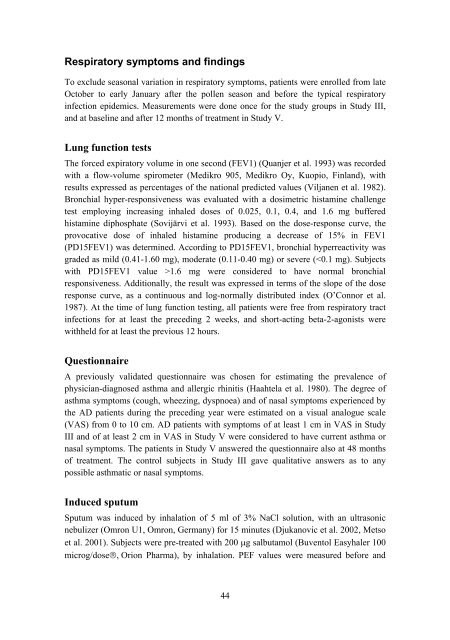Topical tacrolimus in atopic dermatitis: Effects of ... - Helda - Helsinki.fi
Topical tacrolimus in atopic dermatitis: Effects of ... - Helda - Helsinki.fi
Topical tacrolimus in atopic dermatitis: Effects of ... - Helda - Helsinki.fi
Create successful ePaper yourself
Turn your PDF publications into a flip-book with our unique Google optimized e-Paper software.
Respiratory symptoms and f<strong>in</strong>d<strong>in</strong>gs<br />
To exclude seasonal variation <strong>in</strong> respiratory symptoms, patients were enrolled from late<br />
October to early January after the pollen season and before the typical respiratory<br />
<strong>in</strong>fection epidemics. Measurements were done once for the study groups <strong>in</strong> Study III,<br />
and at basel<strong>in</strong>e and after 12 months <strong>of</strong> treatment <strong>in</strong> Study V.<br />
Lung function tests<br />
The forced expiratory volume <strong>in</strong> one second (FEV1) (Quanjer et al. 1993) was recorded<br />
with a flow-volume spirometer (Medikro 905, Medikro Oy, Kuopio, F<strong>in</strong>land), with<br />
results expressed as percentages <strong>of</strong> the national predicted values (Viljanen et al. 1982).<br />
Bronchial hyper-responsiveness was evaluated with a dosimetric histam<strong>in</strong>e challenge<br />
test employ<strong>in</strong>g <strong>in</strong>creas<strong>in</strong>g <strong>in</strong>haled doses <strong>of</strong> 0.025, 0.1, 0.4, and 1.6 mg buffered<br />
histam<strong>in</strong>e diphosphate (Sovijärvi et al. 1993). Based on the dose-response curve, the<br />
provocative dose <strong>of</strong> <strong>in</strong>haled histam<strong>in</strong>e produc<strong>in</strong>g a decrease <strong>of</strong> 15% <strong>in</strong> FEV1<br />
(PD15FEV1) was determ<strong>in</strong>ed. Accord<strong>in</strong>g to PD15FEV1, bronchial hyperreactivity was<br />
graded as mild (0.41-1.60 mg), moderate (0.11-0.40 mg) or severe (1.6 mg were considered to have normal bronchial<br />
responsiveness. Additionally, the result was expressed <strong>in</strong> terms <strong>of</strong> the slope <strong>of</strong> the dose<br />
response curve, as a cont<strong>in</strong>uous and log-normally distributed <strong>in</strong>dex (O’Connor et al.<br />
1987). At the time <strong>of</strong> lung function test<strong>in</strong>g, all patients were free from respiratory tract<br />
<strong>in</strong>fections for at least the preced<strong>in</strong>g 2 weeks, and short-act<strong>in</strong>g beta-2-agonists were<br />
withheld for at least the previous 12 hours.<br />
Questionnaire<br />
A previously validated questionnaire was chosen for estimat<strong>in</strong>g the prevalence <strong>of</strong><br />
physician-diagnosed asthma and allergic rh<strong>in</strong>itis (Haahtela et al. 1980). The degree <strong>of</strong><br />
asthma symptoms (cough, wheez<strong>in</strong>g, dyspnoea) and <strong>of</strong> nasal symptoms experienced by<br />
the AD patients dur<strong>in</strong>g the preced<strong>in</strong>g year were estimated on a visual analogue scale<br />
(VAS) from 0 to 10 cm. AD patients with symptoms <strong>of</strong> at least 1 cm <strong>in</strong> VAS <strong>in</strong> Study<br />
III and <strong>of</strong> at least 2 cm <strong>in</strong> VAS <strong>in</strong> Study V were considered to have current asthma or<br />
nasal symptoms. The patients <strong>in</strong> Study V answered the questionnaire also at 48 months<br />
<strong>of</strong> treatment. The control subjects <strong>in</strong> Study III gave qualitative answers as to any<br />
possible asthmatic or nasal symptoms.<br />
Induced sputum<br />
Sputum was <strong>in</strong>duced by <strong>in</strong>halation <strong>of</strong> 5 ml <strong>of</strong> 3% NaCl solution, with an ultrasonic<br />
nebulizer (Omron U1, Omron, Germany) for 15 m<strong>in</strong>utes (Djukanovic et al. 2002, Metso<br />
et al. 2001). Subjects were pre-treated with 200 �g salbutamol (Buventol Easyhaler 100<br />
microg/dose���Orion Pharma), by <strong>in</strong>halation. PEF values were measured before and<br />
44

















